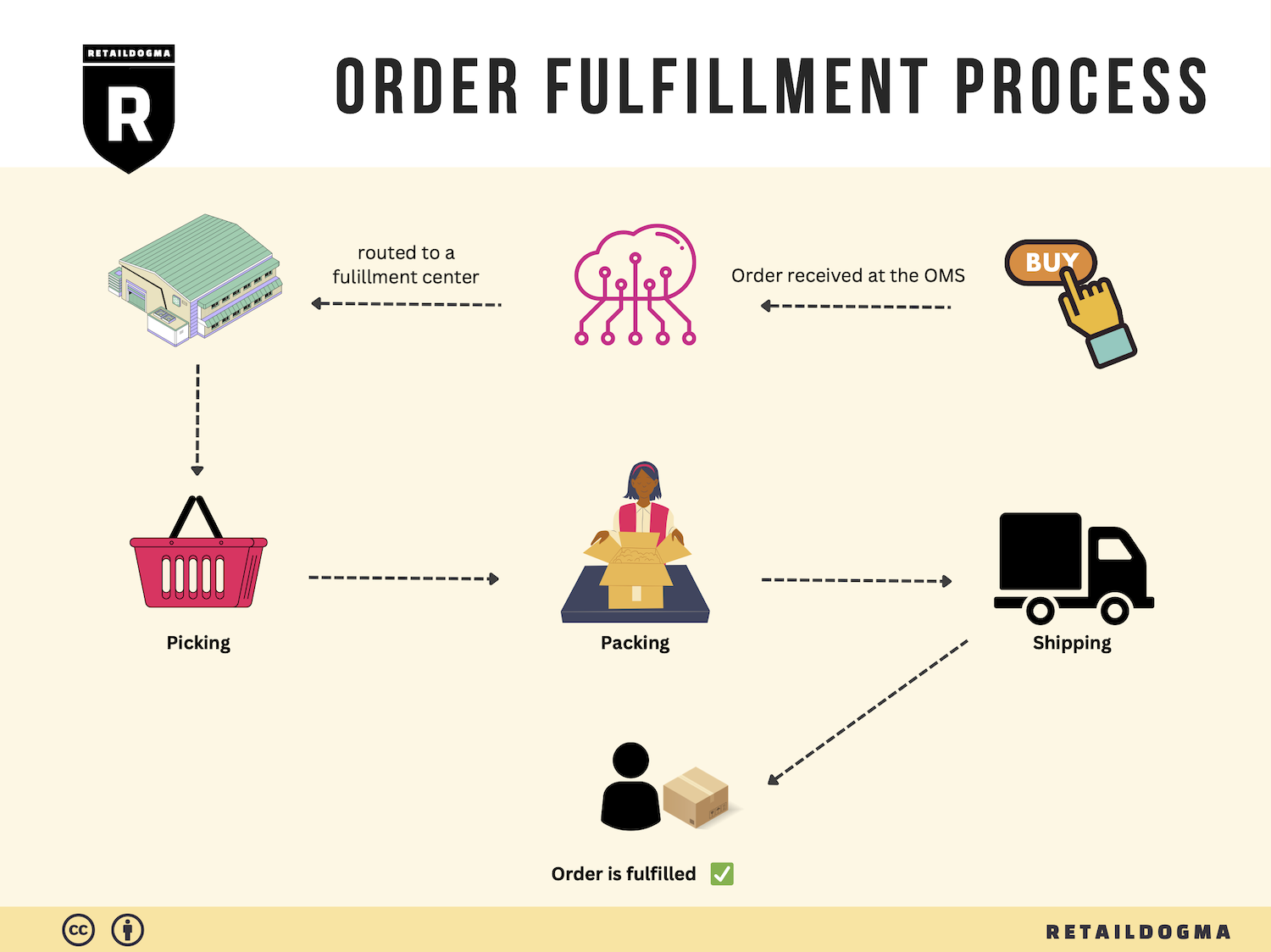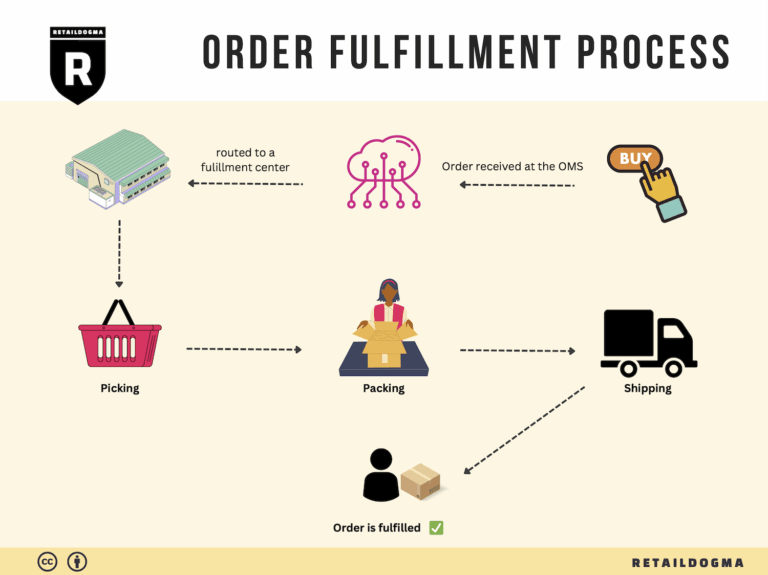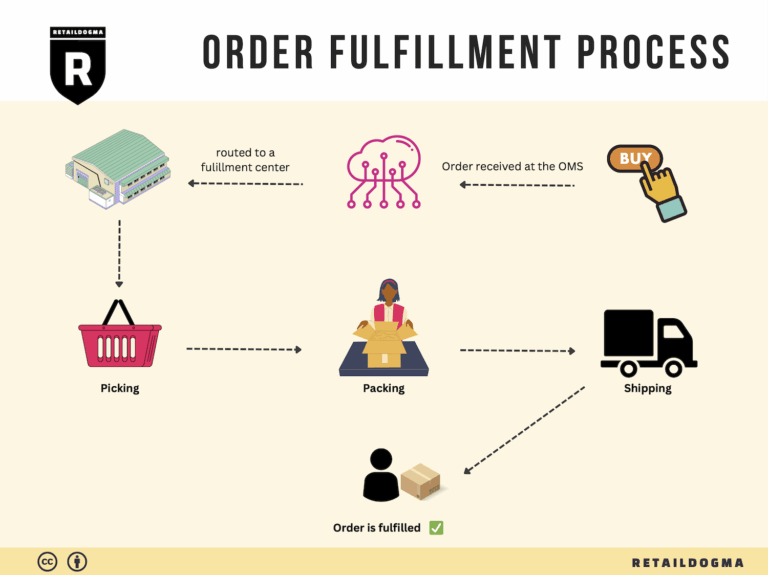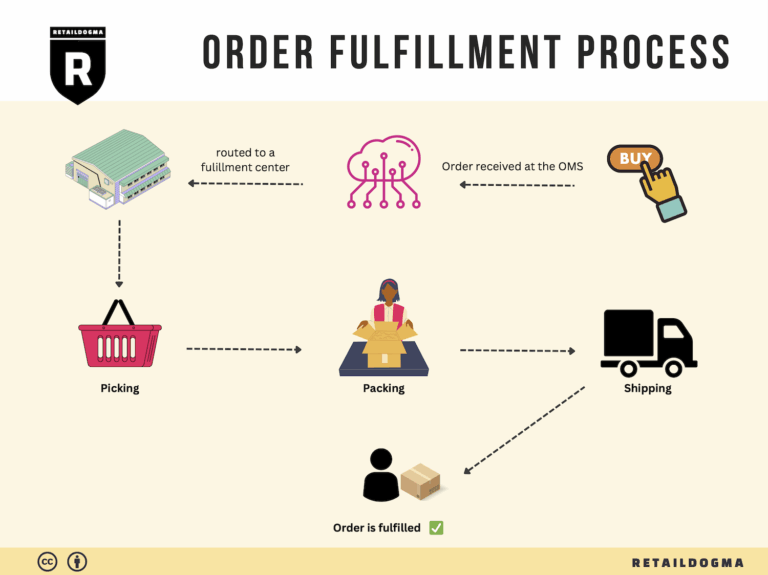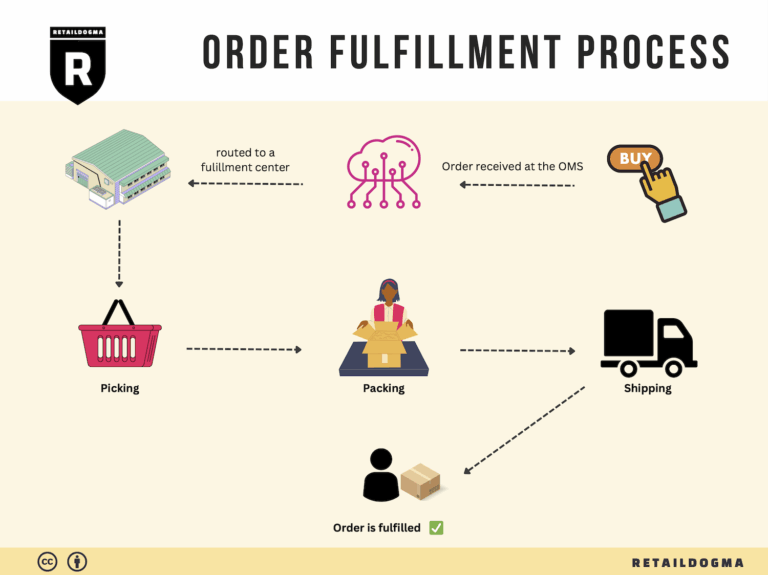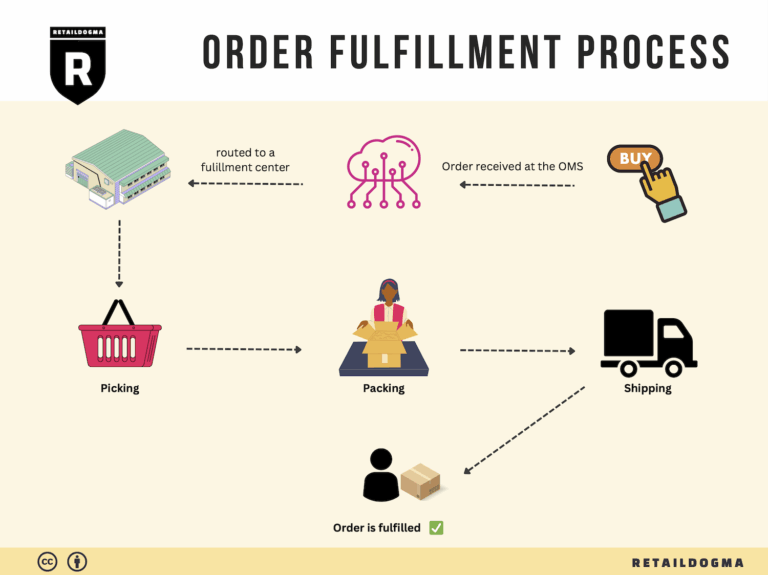Ecommerce Fulfillment Services: The Ultimate Guide (2025)
What is E-commerce Fulfillment? An Introduction for Growing Businesses
As your e-commerce business begins to flourish, the excitement of increased sales can quickly be overshadowed by the daunting task of managing packing and shipping orders. Many growing online retailers find themselves overwhelmed, juggling inventory management, order processing, and customer service—all while trying to maintain a high level of customer satisfaction. This is where e-commerce fulfillment comes into play.
Understanding E-commerce Fulfillment
At its core, e-commerce fulfillment is the comprehensive process of getting products from your warehouse to your customers’ doorsteps. This involves several key stages: receiving inventory, storing products, picking and packing orders, shipping, and handling returns. As your business scales, these logistical challenges can become increasingly complex, making it essential to implement an efficient fulfillment strategy.
What This Guide Will Cover
In this guide, we will explore various fulfillment models, including Third-Party Logistics (3PL) and Fulfillment by Amazon (FBA), to help you determine the best fit for your business needs. We will delve into the core services offered by fulfillment partners, such as inventory management, order processing, and returns handling, allowing you to understand the full spectrum of support available.
We will also provide practical advice on how to choose the right fulfillment partner for your business. Selecting a fulfillment service is a critical decision that can impact your operational efficiency and customer satisfaction. We will outline the key factors to consider, including service reliability, technology integration, and customer support.
Furthermore, we will discuss pricing structures commonly associated with e-commerce fulfillment services. Understanding the cost implications of different fulfillment options will empower you to make informed financial decisions as you scale your operations.
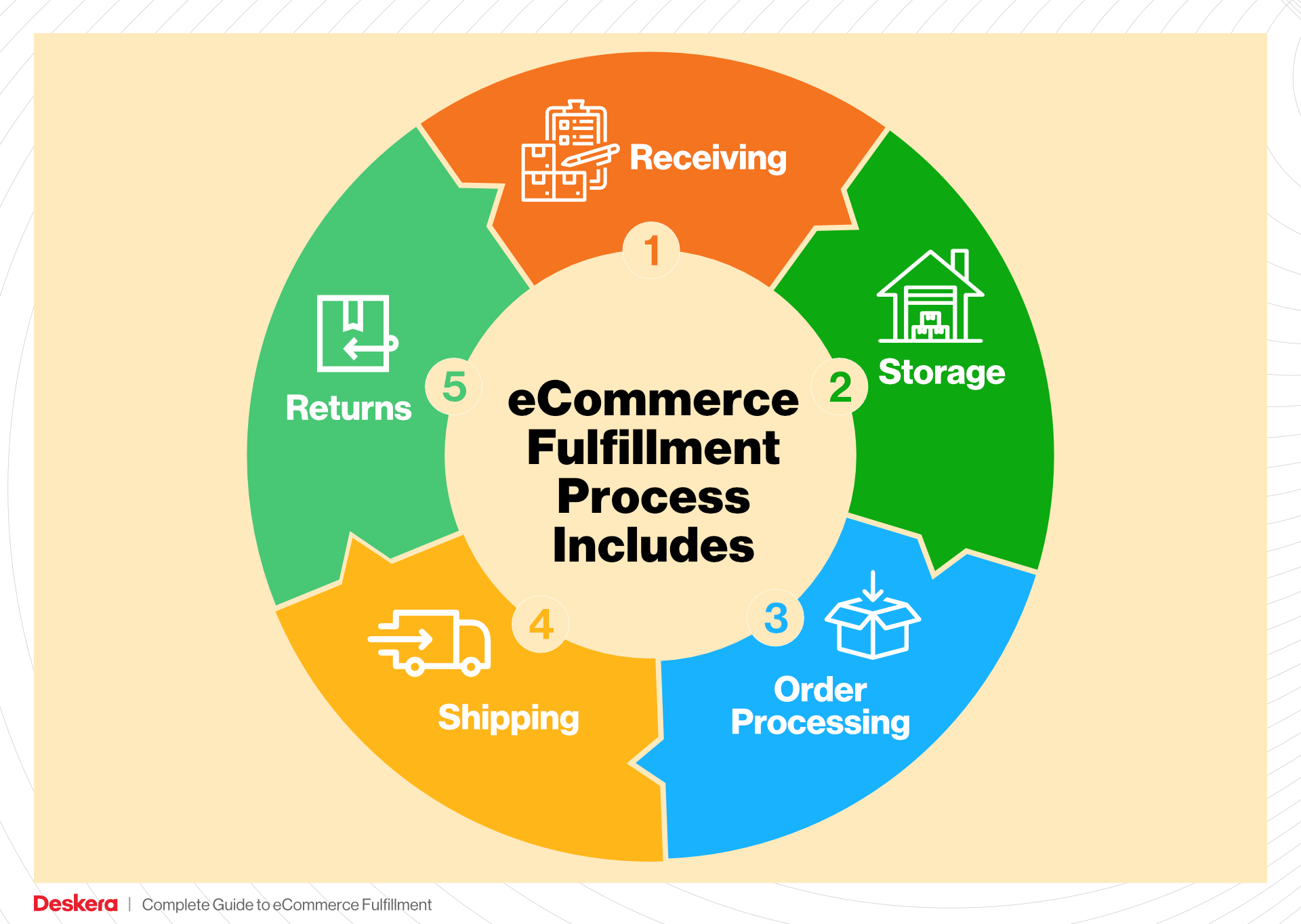
Empowering Your Business
Our goal with this guide is to equip you with the knowledge necessary to make smart decisions about your logistics. By understanding the intricacies of e-commerce fulfillment, you can streamline your operations, enhance customer satisfaction, and ultimately drive growth for your business. Whether you are a startup looking to establish your fulfillment strategy or an established brand aiming to optimize your logistics, this guide will serve as a valuable resource in navigating the world of e-commerce fulfillment.
What You’ll Learn In This Guide
- What is E-commerce Fulfillment? An Introduction for Growing Businesses
- The Order Fulfillment Process: From ‘Buy’ Button to Customer’s Door
- Comparing Fulfillment Models: In-House vs. 3PL vs. Dropshipping
- A Deep Dive into Amazon FBA: Pros, Cons, and Who It’s For
- Core Services Offered by Fulfillment Centers
- How to Choose a Fulfillment Partner: A 6-Point Checklist
- Understanding Fulfillment Pricing: A Breakdown of Common Fees
- Frequently Asked Questions (FAQs) about Fulfillment
- Conclusion: Is Outsourcing Fulfillment the Right Move for Your Business?
- Important Disclaimer
The Order Fulfillment Process: From ‘Buy’ Button to Customer’s Door
1. Receiving Inventory
The order fulfillment process begins with receiving inventory from suppliers or manufacturers. This step is crucial as it establishes the foundation for your stock management and overall fulfillment efficiency. Upon arrival, each item is inspected for quality and accuracy against purchase orders. This verification process ensures that the correct quantities and product types have been delivered.
Key Term: SKU (Stock Keeping Unit)
Each product should have a unique SKU that facilitates tracking within your inventory management system. Proper inventory receiving allows businesses to maintain accurate stock levels and prevent issues like stockouts or excess inventory. Accurate receiving is essential for building a reliable inventory database, which directly impacts order fulfillment speed and customer satisfaction.
2. Warehouse Storage
Once the inventory is received and accounted for, it is stored in a designated area of the warehouse. Effective warehouse storage strategies are vital for optimizing space and ensuring quick access to products. Products should be organized based on their categories, sizes, or sales velocity, enabling efficient retrieval.
Key Term: Bin Locations
Assigning bin locations for each SKU helps streamline the storage process. This method allows warehouse staff to quickly locate items, which is particularly important during high-demand periods. Efficient storage minimizes the time spent searching for products, thus enhancing overall operational efficiency and reducing lead times for order fulfillment.
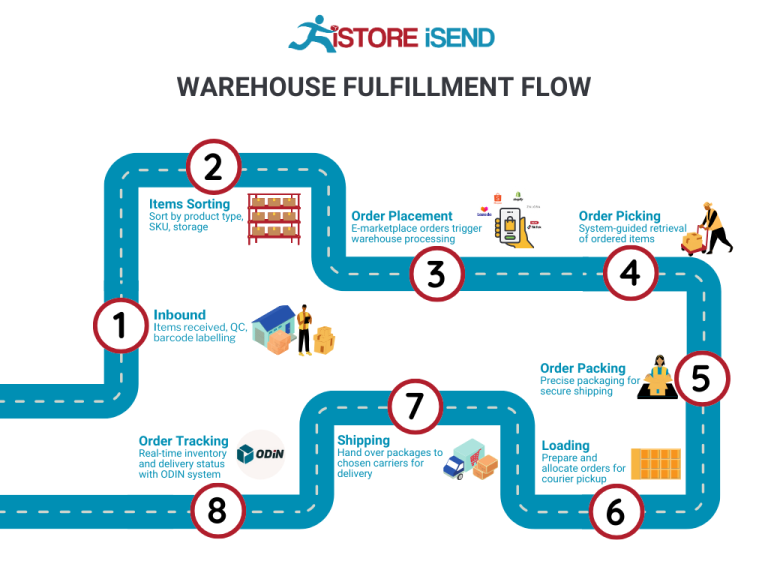
3. Order Picking
When a customer places an order, the next step is order picking, where items are selected from storage to fulfill the order. This step is crucial as it directly influences order accuracy and fulfillment speed. A well-structured picking process can significantly enhance operational efficiency and customer satisfaction.
Key Term: Pick Lists
A pick list is generated for each order, detailing the SKUs and quantities required. This document guides warehouse staff through the picking process, ensuring that the right items are selected. Various picking methods, such as single order picking or batch picking, can be employed based on the volume of orders. Implementing efficient picking strategies helps minimize errors and reduces the time taken to prepare orders for shipment.
4. Order Packing
After items are picked, they move to the packing stage. This step is essential for ensuring that products are packaged securely to prevent damage during transit. A well-executed packing process enhances the unboxing experience, which can contribute to customer satisfaction and brand loyalty.
Key Term: Packaging Materials
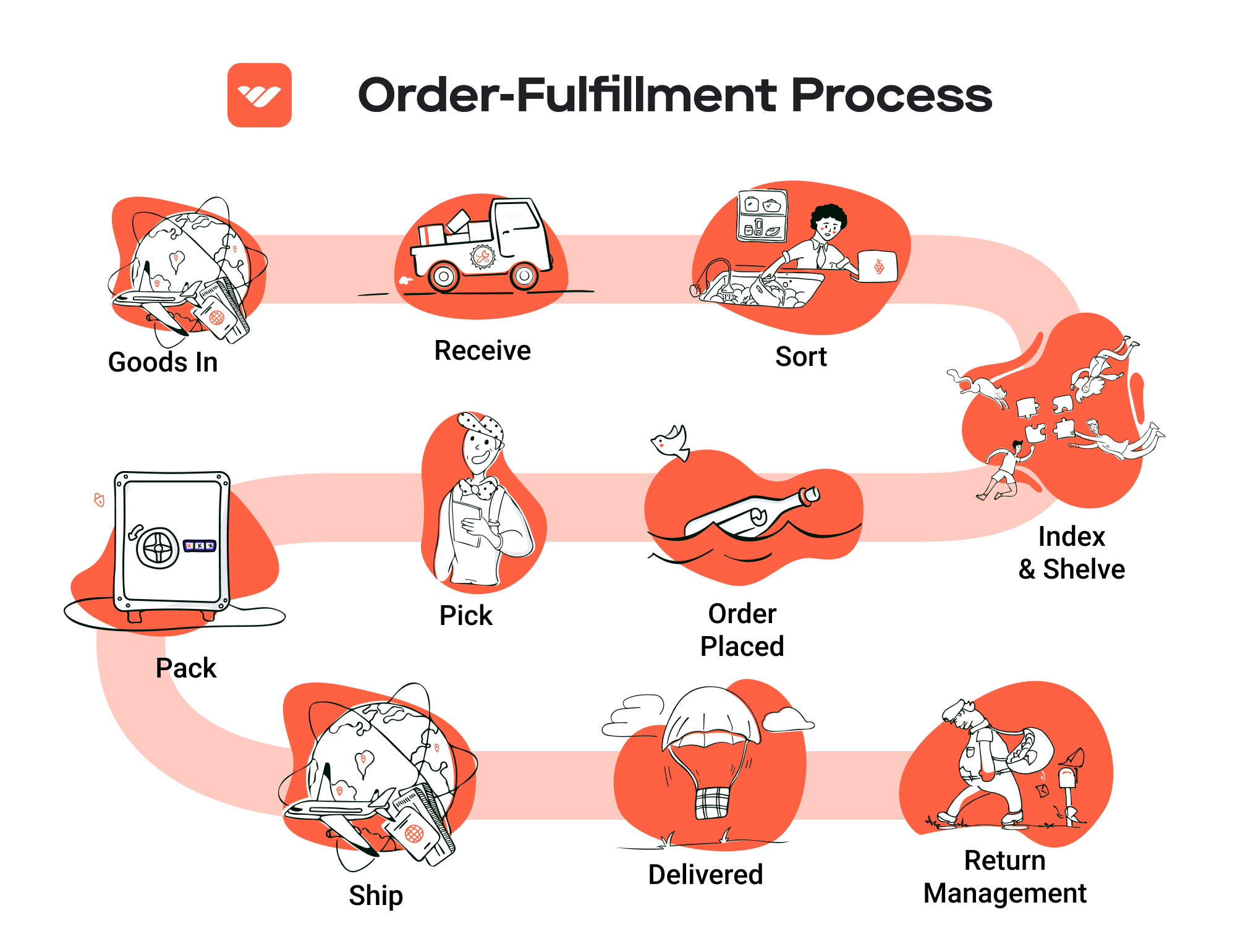
Using appropriate packaging materials—such as bubble wrap, packing peanuts, or branded boxes—ensures that products arrive safely at the customer’s doorstep. Additionally, including packing slips and promotional materials can enhance customer engagement. Effective packing not only protects the items but also reflects your brand’s attention to detail and commitment to quality.
5. Shipping & Delivery
The final step in the order fulfillment process is shipping and delivery. Once orders are packed, they are labeled and dispatched through a reliable shipping carrier. This step is vital as it determines how quickly and efficiently products reach customers, significantly impacting their overall experience.
Key Term: Shipping Carrier
Choosing the right shipping carrier, such as USPS, UPS, or FedEx, can affect shipping costs and delivery times. Businesses should evaluate their options based on service levels, delivery speed, and cost-effectiveness. Additionally, providing customers with tracking information enhances transparency and allows them to monitor their orders in real-time. Efficient shipping practices not only improve customer satisfaction but also support repeat business and brand loyalty.
In conclusion, mastering the order fulfillment process—from receiving inventory to shipping—enables e-commerce businesses to scale effectively. By focusing on each step’s importance and implementing best practices, companies can enhance operational efficiency and foster positive customer experiences.
Comparing Fulfillment Models: In-House vs. 3PL vs. Dropshipping
Fulfillment Models Comparison
| Model | Who Handles Inventory | Best For (Business Stage) | Key Advantage | Key Disadvantage |
|---|---|---|---|---|
| In-House Fulfillment | The business itself | Startups to established businesses | Complete control over inventory and fulfillment processes | High overhead costs and resource demands |
| Third-Party Logistics (3PL) | Third-party providers | Growing businesses and scaling operations | Cost-effective and scalable solutions without significant upfront investment | Potential loss of control over logistics |
| Dropshipping | Supplier or manufacturer | New businesses and small retailers | Minimal investment and no inventory risk | Lower profit margins and less control over shipping times |
In-House Fulfillment
In-house fulfillment involves managing all aspects of inventory and order processing within the business itself. This model is particularly suitable for startups that have established a stable product line and wish to maintain complete control over their inventory, logistics, and customer experience. By handling fulfillment internally, businesses can customize their processes to align with their brand values, ensuring a consistent customer experience.
However, managing in-house fulfillment can be resource-intensive. It requires significant investment in warehousing, staff, technology, and equipment. Businesses must also be prepared to handle seasonal fluctuations and peak periods, which can strain resources. Additionally, as the business scales, the complexity of managing logistics can increase, requiring more sophisticated systems and processes. For businesses committed to maintaining high levels of quality control and personalization in their fulfillment, in-house operations can be an effective, albeit demanding, solution.
Third-Party Logistics (3PL)
Third-party logistics providers (3PLs) offer outsourced fulfillment services that can handle inventory management, warehousing, picking, packing, and shipping. This model is ideal for growing businesses that need to scale quickly without the burden of managing logistics in-house. Partnering with a 3PL allows businesses to leverage the expertise and resources of established logistics providers, often resulting in faster shipping times and reduced operational costs.
The key advantage of using a 3PL is the ability to scale operations efficiently. As order volumes increase, 3PLs can expand their services without the business needing to invest heavily in infrastructure or staffing. Many 3PLs also provide advanced technology solutions, such as real-time inventory management and order tracking, enhancing operational efficiency and visibility. However, a potential downside is the loss of direct control over the fulfillment process, which can lead to inconsistencies in service quality if the 3PL does not meet the business’s standards. Moreover, businesses must carefully select a 3PL partner that aligns with their values and customer service expectations to ensure a seamless experience for their customers.
Dropshipping
Dropshipping is a fulfillment model where the retailer does not keep the products it sells in stock. Instead, when a retailer sells a product, it purchases the item from a third party—typically a manufacturer or wholesaler—who ships it directly to the customer. This model is particularly attractive for new businesses and small retailers because it requires minimal upfront investment in inventory. Retailers can offer a wide range of products without the risk of overstocking or managing inventory.
While dropshipping offers low barriers to entry, it also comes with its own set of challenges. The most significant disadvantage is the typically lower profit margins due to reliance on third-party suppliers. Additionally, retailers have less control over shipping times and product quality, which can negatively impact customer satisfaction. Issues such as stock shortages or shipping delays can arise, and retailers may find it challenging to provide excellent customer service in these situations. Therefore, while dropshipping can be an appealing option for businesses looking to minimize risk, it requires careful management of supplier relationships and customer expectations to be successful.
Conclusion
Choosing the right fulfillment model is critical for e-commerce businesses looking to scale effectively. Each model—whether in-house fulfillment, third-party logistics, or dropshipping—offers unique advantages and disadvantages. Businesses must assess their current operational capabilities, customer expectations, and long-term growth strategies when selecting the most suitable fulfillment approach. By understanding the strengths and limitations of each model, entrepreneurs can make informed decisions that align with their business goals and customer needs, ultimately driving growth and enhancing customer satisfaction.
A Deep Dive into Amazon FBA: Pros, Cons, and Who It’s For
What is Fulfillment by Amazon (FBA)?
Fulfillment by Amazon (FBA) is a service provided by Amazon that allows e-commerce sellers to store their products in Amazon’s fulfillment centers. When a customer places an order, Amazon takes care of storage, packaging, and shipping on behalf of the seller. This service leverages Amazon’s extensive logistics network, enabling sellers to reach a vast customer base while minimizing the complexities associated with order fulfillment.
With FBA, sellers can also benefit from Amazon’s customer service and returns handling, which can significantly enhance the customer experience. Furthermore, products fulfilled through FBA are eligible for Amazon Prime and other Amazon services, providing sellers with a competitive edge in the marketplace.
How FBA Works
-
Setting Up Your FBA Account: To get started, sellers must create an Amazon seller account and enroll in the FBA program. This involves providing necessary business information and agreeing to FBA terms and conditions.
-
Product Preparation: Sellers prepare their products according to Amazon’s guidelines, which include labeling and packaging requirements. Proper preparation ensures that products are ready for storage and shipment.
-
Shipping Inventory to Amazon: Once products are prepared, sellers ship them to Amazon’s fulfillment centers. Amazon provides shipping plans and instructions to streamline this process.
-
Storage and Order Fulfillment: Products are stored in Amazon’s warehouses. When a customer places an order, Amazon picks, packs, and ships the product directly to the customer. Sellers can monitor their inventory and sales performance through the seller dashboard.
-
Customer Service and Returns: Amazon handles all customer inquiries and returns for FBA orders. This includes managing customer feedback and processing return requests, allowing sellers to focus on growing their business.
Pros of Fulfillment by Amazon (FBA)
-
Prime Eligibility: One of the most significant advantages of FBA is that products become eligible for Amazon Prime. This increases visibility and attractiveness to customers who prefer fast, free shipping, significantly boosting sales potential.
-
Customer Trust: Amazon is a trusted brand with a reputation for excellent customer service. By using FBA, sellers can leverage this trust, as customers are more likely to purchase products fulfilled by Amazon due to the perceived reliability.
-
Multi-Channel Fulfillment: FBA isn’t limited to Amazon sales alone. Sellers can use FBA to fulfill orders from their own websites and other sales channels. This multi-channel fulfillment capability allows for a more streamlined logistics operation.
-
Scalability: As businesses grow, FBA provides the scalability needed to manage increased order volumes without the need for additional warehousing or staffing.
-
Time-Saving: By outsourcing logistics to Amazon, sellers can save significant time and resources, allowing them to focus on other critical aspects of their business, such as product development and marketing.
Cons of Fulfillment by Amazon (FBA)
-
High Fees: FBA comes with a variety of fees, including storage fees and fulfillment fees. These can quickly add up, especially for sellers with lower-priced items or those with slow-moving inventory. Sellers must carefully calculate their costs to ensure profitability.
-
Strict Inventory Rules: Amazon has stringent rules regarding inventory management, including limits on the number of units that can be stored in fulfillment centers. Sellers may face additional costs if their inventory exceeds these limits or if items are deemed unsellable.
-
Commingling Risks: FBA uses a commingled inventory system, meaning that sellers’ products may be mixed with those of other sellers. This can lead to complications, such as receiving returns of items that don’t belong to the seller, potentially impacting brand reputation and customer satisfaction.
-
Limited Control: When using FBA, sellers relinquish a degree of control over the fulfillment process, including packaging and shipping. This can be a concern for brands that prioritize a specific customer experience or branding in their packaging.
-
Potential for Long-Term Storage Fees: If inventory remains in Amazon’s warehouses for an extended period, sellers may incur long-term storage fees. This can be particularly problematic for seasonal products or items that do not sell quickly.
Who is FBA Best For?
FBA is particularly beneficial for small to medium-sized e-commerce businesses looking to scale rapidly without the burden of managing logistics. It is ideal for:
-
New Sellers: Entrepreneurs just starting in e-commerce can take advantage of Amazon’s vast customer base and logistics expertise, allowing them to compete with larger brands.
-
Seasonal Businesses: Companies with seasonal products can benefit from FBA’s scalability, as they can increase inventory without investing in additional warehousing.
-
Brands Seeking Growth: Established brands that want to expand their reach and enhance customer trust can leverage FBA to improve their logistics and customer service.
-
Multi-Channel Sellers: Businesses that sell on multiple platforms can streamline their operations by using FBA to fulfill orders from various sales channels.
While FBA can provide significant advantages, it is essential for sellers to carefully evaluate their product offerings, margins, and business model to determine if the benefits outweigh the potential downsides. Understanding these factors will help e-commerce business owners make informed decisions about whether FBA is the right fulfillment solution for their needs.
Core Services Offered by Fulfillment Centers
Inventory Management & Warehousing
Effective inventory management and warehousing are pivotal for any e-commerce business looking to scale. Fulfillment centers provide dedicated space for storing products, allowing businesses to manage their stock levels efficiently. These centers utilize advanced inventory management systems that offer real-time tracking of stock levels, which helps in preventing stockouts and overstock situations.
The benefits of utilizing a fulfillment center for inventory management are manifold. First, it alleviates the burden of maintaining a warehouse, which can be costly and labor-intensive. By outsourcing this function, e-commerce businesses can focus on core activities such as marketing and product development. Additionally, many fulfillment centers offer flexible storage solutions without long-term contracts, enabling businesses to adjust their storage needs based on fluctuating demand. This flexibility is crucial for seasonal businesses or those experiencing rapid growth, allowing them to scale operations without incurring unnecessary costs.
Pick and Pack Services
Pick and pack services are a fundamental component of fulfillment operations. This process involves selecting products from the warehouse based on customer orders (picking) and then packaging them appropriately for shipment (packing). Fulfillment centers employ trained staff and sophisticated systems to ensure high accuracy and efficiency in this process.
The advantages of utilizing pick and pack services are clear. By outsourcing these tasks, e-commerce businesses can significantly reduce order processing times, ensuring that customers receive their orders quickly. Furthermore, many fulfillment centers offer customizable packing options, allowing businesses to enhance their brand identity through personalized packaging. This attention to detail can improve customer satisfaction and foster brand loyalty, as customers appreciate the extra effort put into their unboxing experience. Additionally, the accuracy provided by professional pick and pack services helps to minimize returns due to order errors, further enhancing operational efficiency.
Kitting and Assembly
Kitting and assembly services involve the process of grouping multiple products together into a single unit or preparing products for sale. This might include assembling items into a kit (such as a gift set) or pre-packaging products in a specific way before shipping. Fulfillment centers that offer kitting services can help businesses streamline their production and shipping processes.
The primary benefit of kitting and assembly services is the ability to create value-added products that meet specific customer needs. This can be particularly advantageous for businesses looking to launch promotional items or limited edition bundles, as it allows for quick and efficient assembly without the need for additional in-house labor. Moreover, kitting can help reduce shipping costs by consolidating multiple items into a single shipment, which can be more economical for both the business and its customers. By outsourcing these services, e-commerce businesses can also enhance operational efficiency, as they no longer need to manage the labor and logistics associated with assembling products themselves.
Returns Management (Reverse Logistics)
Returns management, also known as reverse logistics, is an essential service provided by fulfillment centers. This process encompasses the entire lifecycle of a returned product, from receiving the returned item to inspecting, restocking, and processing refunds or exchanges. A well-managed returns process is critical for maintaining customer satisfaction and loyalty in the e-commerce landscape.
The benefits of effective returns management are significant. Firstly, it simplifies the often-complex returns process for both the business and the customer. By outsourcing this function, e-commerce businesses can ensure that returns are handled efficiently and transparently, which can improve customer trust and retention. Fulfillment centers often have established processes for inspecting returned items, determining their condition, and restocking them appropriately. This level of expertise helps businesses manage their inventory more effectively and minimize losses associated with returns. Additionally, a streamlined returns process can provide valuable insights into product performance and customer preferences, enabling businesses to make informed decisions about inventory and product offerings.
In summary, leveraging the core services of fulfillment centers—inventory management and warehousing, pick and pack services, kitting and assembly, and returns management—can provide significant advantages for e-commerce businesses looking to scale. By outsourcing these functions, businesses can enhance operational efficiency, reduce costs, and ultimately improve customer satisfaction, positioning themselves for sustainable growth in a competitive marketplace.
How to Choose a Fulfillment Partner: A 6-Point Checklist
Location & Warehouse Network
The location of your fulfillment partner’s warehouses can significantly impact shipping times and costs. A strategically located warehouse network allows for quicker delivery to your customers, which is crucial in today’s fast-paced e-commerce environment.
Questions to Ask:
– Where are your warehouses located, and how do they align with my target market?
– What is your average shipping time to major regions or cities?
– Do you have a network of warehouses that can accommodate seasonal fluctuations in demand?
Technology & Integrations
In an era where efficiency is paramount, the technology used by your fulfillment partner is critical. A robust fulfillment system that integrates seamlessly with your e-commerce platform can streamline operations, reduce errors, and provide real-time visibility into your inventory and shipments.
Questions to Ask:
– What order management system do you use, and how does it integrate with popular e-commerce platforms?
– Do you offer real-time inventory tracking, and how can I access this information?
– Can your system handle automated order processing and returns management?
Specializations (e.g., Cold Storage, Oversized Items)
Different businesses have unique needs based on the type of products they sell. Whether you require cold storage for perishables or specialized handling for oversized items, choosing a partner with the right capabilities can save you time and ensure your products are stored and shipped correctly.
Questions to Ask:
– What types of products do you specialize in handling?
– Do you have specific facilities for temperature-sensitive items or oversized goods?
– Can you accommodate unique packaging or kitting requirements?
Scalability & Capacity
As your business grows, your fulfillment needs will evolve. It’s vital to partner with a fulfillment provider that can scale with you—whether that means increasing warehouse space, adding staff during peak seasons, or expanding shipping options.
Questions to Ask:
– How do you manage capacity during peak seasons, such as holidays?
– Can you provide examples of how you have scaled operations for other clients?
– What is your process for forecasting and managing inventory levels?
Pricing and Contracts
Understanding the pricing structure and contract terms of your fulfillment partner is crucial to avoid unexpected costs that can eat into your margins. Look for transparency in pricing and flexibility in contracts, ensuring that the terms align with your business goals.
Questions to Ask:
– What is included in your pricing model (e.g., storage fees, pick and pack fees, shipping costs)?
– Are there any hidden fees or long-term contracts I should be aware of?
– How do you handle pricing adjustments during contract renewals?
Customer Support & Reviews
Reliable customer support is essential for a smooth fulfillment process. The level of support you receive can affect your operational efficiency and customer satisfaction. Additionally, researching reviews and testimonials can give you insights into the experiences of other businesses.
Questions to Ask:
– What kind of customer support do you offer (e.g., dedicated account manager, 24/7 support)?
– How do you handle issues like shipping delays or inventory discrepancies?
– Can you provide references or case studies from other clients in my industry?
Conclusion
Selecting the right fulfillment partner is a crucial step in scaling your e-commerce business. By using this checklist, you can evaluate potential partners based on their location, technology, specialization, scalability, pricing, and customer support. This careful assessment will help ensure that your chosen partner aligns with your operational needs and growth objectives, ultimately contributing to your success in the competitive e-commerce landscape.
Understanding Fulfillment Pricing: A Breakdown of Common Fees
Initial Setup Fees
Initial setup fees are one-time charges that many fulfillment services impose to cover the cost of onboarding a new client. These fees may include the configuration of your inventory in their system, integration with your e-commerce platform, and the establishment of shipping parameters. While some providers may charge a flat fee, others might base it on the complexity of your requirements or the volume of products you will be listing.
To minimize initial setup costs, consider working with fulfillment partners that offer no setup fees or those that provide free onboarding services. Always inquire about what is included in the setup fee and ensure you understand the entire process before committing.
Receiving Fees
Receiving fees are charged when the fulfillment center receives your products. This fee compensates the warehouse for the labor involved in unloading, inspecting, and entering the inventory into their system. Charges can vary based on the volume of goods received and the complexity of the receiving process, such as whether the items need to be sorted, repackaged, or labeled.
Typically, receiving fees are calculated per shipment or per unit, and they may include additional charges for special handling, such as dealing with fragile or oversized items. To keep costs predictable, it’s advisable to send consolidated shipments whenever possible and ensure that your products are well-labeled and organized.
Storage Fees (per pallet/bin)
Storage fees cover the cost of holding your inventory in the fulfillment center. These fees are usually calculated based on the space your products occupy, whether it’s measured per pallet, bin, or shelf. The rates can vary significantly depending on the provider and the location of the warehouse, as prime locations may command higher storage fees.
Some fulfillment centers may offer tiered pricing based on the amount of inventory stored, with lower rates for larger volumes. Be mindful of how long your products remain in storage, as many providers have a threshold after which long-term storage fees apply. To manage storage costs effectively, practice proactive inventory management to avoid overstocking.
Pick & Pack Fees (per item/order)
Pick and pack fees are charged for the labor involved in retrieving items from storage and preparing them for shipment. This fee is typically calculated on a per-item basis, though some providers may charge a flat fee per order regardless of the number of items. The complexity of the order can also influence the fee; for instance, kitting services or special packaging may incur additional charges.
To optimize pick and pack costs, streamline your product offerings and reduce order complexity. Consider choosing a fulfillment partner that allows for bulk order processing or offers incentives for higher order volumes.
Shipping Fees
Shipping fees encompass the costs associated with transporting your products to customers. These fees can vary widely based on several factors, including the weight and dimensions of the package, the shipping method selected (e.g., standard, expedited), and the destination (domestic vs. international). Fulfillment centers often negotiate rates with carriers, and these savings can sometimes be passed on to you.
To get the best shipping rates, partner with fulfillment providers that have established relationships with multiple carriers. Additionally, consider utilizing their shipping technology to automatically select the most cost-effective shipping option based on the specifics of each order.
Tips for Getting an Accurate Quote
-
Define Your Needs: Before reaching out for quotes, have a clear understanding of your business requirements, including your expected order volume, product types, and fulfillment expectations.
-
Request Detailed Quotes: When soliciting quotes from fulfillment services, ask for itemized breakdowns of all potential fees. This transparency will help you compare costs effectively.
-
Inquire About Hidden Fees: Ensure you ask about any additional or hidden fees that may not be immediately apparent, such as charges for returns or special handling.
-
Assess Scalability: Choose a provider that can grow with your business. Ensure that their pricing model accommodates fluctuations in order volume without significant increases in fees.
-
Negotiate Terms: Don’t hesitate to negotiate terms, especially if you expect high volumes or have unique fulfillment needs. Many providers are willing to adjust their pricing structures to secure your business.
By understanding these common fulfillment pricing models and actively engaging with potential fulfillment partners, you can make informed decisions that align with your business growth objectives.
Frequently Asked Questions (FAQs) about Fulfillment
1. What is e-commerce fulfillment?
E-commerce fulfillment refers to the complete process of storing, packing, and shipping products sold online. It involves receiving inventory, managing stock levels, processing orders, and ensuring timely delivery to customers. Efficient fulfillment services can enhance customer satisfaction and drive repeat business.
2. What is the difference between a warehouse and a fulfillment center?
While both warehouses and fulfillment centers are used for storing inventory, their functions differ significantly. A warehouse primarily focuses on storage and may not handle order processing or shipping. In contrast, a fulfillment center is designed to manage the entire order fulfillment process, including picking, packing, and shipping products directly to customers.
3. What is a 3PL (Third-Party Logistics)?
A Third-Party Logistics provider (3PL) is a company that offers outsourced logistics services, including warehousing, fulfillment, and shipping. E-commerce businesses often partner with 3PLs to manage their logistics more efficiently, allowing them to focus on core business activities like marketing and product development.
4. How much do fulfillment services cost?
Fulfillment service costs can vary widely based on factors such as storage space, order volume, shipping methods, and additional services (like kitting or returns management). Typically, costs can range from a few dollars per order to a percentage of sales. It’s essential to request quotes from multiple providers to compare pricing structures.
5. What should I consider when choosing a fulfillment partner?
When selecting a fulfillment partner, consider their experience in your industry, the technology they use (such as inventory management systems), shipping options, customer service, and scalability. Assess their ability to handle peak seasons and their track record of order accuracy and reliability.
6. How does inventory management work in fulfillment services?
Inventory management in fulfillment services involves tracking stock levels in real-time, forecasting demand, and ensuring that products are available for order processing. Most fulfillment providers offer integrated systems that allow businesses to monitor inventory, set alerts for low stock, and manage orders seamlessly.
7. Can I integrate my e-commerce platform with fulfillment services?
Yes, many fulfillment services offer integrations with popular e-commerce platforms and shopping carts. This integration enables automatic updates on inventory levels, order processing, and shipping notifications, streamlining your operations and reducing manual work.
8. What is the typical order processing time in fulfillment services?
Order processing times can vary depending on the fulfillment provider and the complexity of the orders. However, many providers aim for same-day or next-day shipping for orders placed before a certain cut-off time. It’s essential to discuss expected processing times with your fulfillment partner to meet customer expectations.
9. How do returns work in fulfillment services?
Fulfillment services typically include returns management as part of their offerings. This process involves receiving returned items, inspecting them for quality, restocking them if applicable, and updating inventory levels. A streamlined returns process can enhance customer satisfaction and encourage repeat business.
10. What are the benefits of using a fulfillment service for my e-commerce business?
Using a fulfillment service can provide numerous benefits, including reduced shipping costs, improved order accuracy, faster delivery times, and the ability to scale operations without significant investment in infrastructure. It allows e-commerce businesses to focus on growth and customer engagement rather than logistics.
Conclusion: Is Outsourcing Fulfillment the Right Move for Your Business?
Evaluating the Benefits of Outsourcing Fulfillment
Outsourcing your e-commerce fulfillment can be a transformative decision for your business. One of the most significant advantages is the time savings it offers. By entrusting a third-party logistics provider (3PL) with warehousing, packing, and shipping, you free up valuable hours that can be redirected toward strategic growth activities, such as product development and marketing. This shift allows you to focus on what truly drives your business forward rather than getting bogged down in logistics.
Another key benefit of partnering with a fulfillment service is scalability. As your business grows, so do your logistics needs. A reliable 3PL can adjust to fluctuations in demand, providing you with the flexibility to scale operations without the burdensome overhead of managing additional staff or warehouse space. This adaptability is crucial in today’s fast-paced e-commerce environment, where customer expectations are high and competition is fierce.
Moreover, fulfillment providers bring expertise to the table. With years of experience in logistics, they can navigate complexities such as international shipping regulations and inventory management more efficiently than most in-house teams. This expertise not only enhances operational efficiency but also improves customer satisfaction through faster shipping times and accurate order fulfillment.
Choosing the Right Partner for Growth
However, the success of outsourcing fulfillment hinges on selecting the right partner. Not all 3PLs are created equal; it’s essential to choose one that aligns with your business goals, understands your industry, and offers transparent communication. A strategic partnership can provide the support and resources necessary for sustainable growth.
Call to Action
As you consider the potential benefits of outsourcing fulfillment, take a moment to audit your current shipping process. Evaluate areas where you could save time, reduce costs, or improve customer experience. If you identify pain points or limitations, it may be time to explore fulfillment services as the next step in your business’s growth journey. Embrace the opportunity to streamline your operations and focus on what you do best—growing your brand.
Important Disclaimer
⚠️ Important Disclaimer
The information in this guide is for educational purposes. Fulfillment services, pricing, and platform features change frequently. Always conduct your own due diligence and consult with providers directly before making business decisions.
